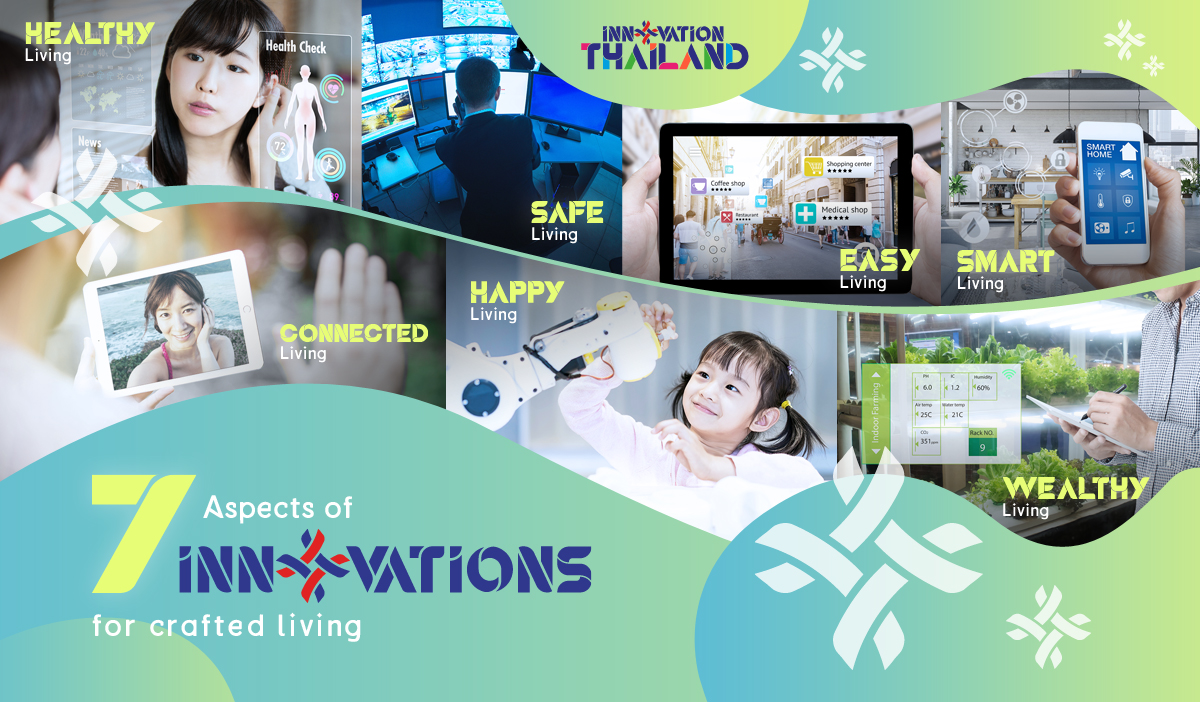News
NIA rebrands Thailand as “innovation nation,” kicks off “Innovation Thailand” campaign with “Innovation for Crafted Living”

The National Innovation Agency (Public Organization) or NIA has launched its most recent “Innovation Thailand” campaign, which seeks to transfigure Thailand from a “cultural destination” to an “innovation nation.” The campaign highlights “Innovation for Crafted Living” as having been an integral part of the Thai people’s way of life, emphasizing and reiterating that many innovations are genuinely Thai.
Thailand’s agricultural richesse and cultural heritage, as well as its citizens’ bright smiles, have attracted visitors and investors from all over the globe. As it moves toward the Fourth Industrial Revolution, Thailand strives to transition from a cultural destination to an innovation nation. In fact, Thai people would argue that innovation has always been an integral part of the Thai way of life. The people of this Southeast Asian country have always enjoyed innovative creations, no matter the level of significance, that make their lives more convenient and fulfilling.
What is an Innovation Nation?
Dr. Suvit Maesincee, Minister of Higher Education, Science, Research and Innovation, explains that innovation has played an increasingly important role in driving economic and social changes. Due to this evident trend, the “Made in Thailand” tagline is no longer sufficient. Thai products now need to bear the moniker “Innovated in Thailand.” In line with the Thai government’s “Thailand 4.0” policy, the ministry seeks to promote and develop urban innovations to bring about happiness to urbanites, meeting their economic, social and environmental requirements. More importantly, these innovations must also foster positive social interaction. Innovations that these individuals need to live a happy life fall under the following four categories:
- “Connected City” innovations bring transportation, education, medicine and other aspects of city living together with 5G infrastructure;
- “Clean City” innovations make urban living more enjoyable by eliminating air pollution, properly managing waste and fostering a good environment by providing a platform on which national agencies, local governments and the citizens themselves can co-operate;
- “Collaborative City” innovations enable people in the same city to interact to create innovations that genuinely cater to their needs; and
- “Creative City” innovations build a unique characteristic or selling point that enable a particular community to generate income.
Thailand is presenting a new façade of its identity that will allow it to be seen by the rest of the world as an innovation nation. This perception change is part of Thailand’s transformative change. This new identity façade is aligned with the country’s stance as an innovation nation. The slogan “Innovation for Crafted Living” of the “Innovation Thailand” campaign will inform the rest of the world of this new image.
What is the Innovation Thailand campaign?
Dr. Pun-arj Chairatana, executive director of the NIA, says that the “Innovation Thailand” campaign requires all sectors to work collaboratively to achieve communication goals, which are to rebrand Thailand as an innovation nation, to garner acceptance and trust in Thai innovations and to earn global recognition of Thailand as an innovation nation. It is a long-term project that encompasses several national transformative changes. The “Innovation Thailand” campaign will deliver a key message and new image to target groups, which includes both foreigners and Thai citizens themselves. The image projected is that of Thailand’s own innate ability to create innovations that make life more refined.
In addition, the “Innovation Thailand” campaign will foster Thai people’s pride in their own innovative creations. The campaign hopes to spark Thai innovators’ creativity, whose creations will further contribute to economic prosperity. Another important target group is foreigners who may be interested in investing in Thai innovations or looking for innovative solutions from Thailand. The campaign makes use of both online and offline platforms to spread its message, including trade events, a website, Facebook posts and video clips. The information transmitted will be incorporated into Thailand’s innovation database. The country’s hub of innovations will allow target groups to access the most up-to-date information about Thai innovations.
Innovation for Crafted Living
Surveys reveal that Thai people make use of innovative creations every day to solve problems or improve their quality of life. This is known as “Innovation for Crafted Living.” There are several ways innovations are employed. They can be sorted into seven categories, examples included.
- “Healthy Living” innovations improve your health and well-being. Examples of these include a ready-to-eat egg white supplement that is rich in albumin and other proteins and plant-based cream and whipped cream that contain 50% less fat than their dairy counterparts.
- “Safety Living” innovations enhances security and welfare. These include the Dinsow mini companion robot that notifies a caretaker whenever the person it monitors suffers from a fall; a nano mosquito net (with a 2-year lifespan) whose netting fiber is infused with a human-safe mosquito repellant (effective after as many as 30 washes) and a fire retardant; and microwavable single-use containers (a eco-friendly plastic alternative) made from bagasse that naturally decompose.
- “Easy Living” innovations make your day to day life less complicated and more convenient. These include time-saving microwavable frozen meals for urbanites with limited time and wheelchair accessible dental chairs that effectively eliminate the risk of falling by allowing individuals who use wheelchairs to wheel themselves in.
- “Smart Living” innovations allow you to be more at ease. For example, a smart monitoring system will record and analyze the operation of the entire network and sends reports to the designated device, allowing you to see if something is going wrong.
- “Connected Living” innovations integrate different systems. For example, the Board of Investment of Thailand (BOI) has launched the Single Window for Visa and Work Permit platform, which interconnects BOI, Immigration Police and Labor Department databases. Companies receiving investment incentives from the BOI may perform several expatriate-hiring tasks on the platform. Their corporate information is linked to the e-Tax system, allowing them to submit corporate tax exemption (per the BOI’s terms and conditions) documents online. The Dinsow mini companion robot also falls under this category because it captures images remotely, features voice command, and remotely notifies a caretaker when the person it monitors suffers from a fall.
- “Wealthy Living” innovations lower expenses, generate additional income and improve quality of life, especially in the agricultural and industrial sectors. These innovative creations typically kill two birds with one stone by making use of agricultural waste to create value-added. For example, low-fat coconut milk from the production of cold-pressed coconut oil can be made into yogurt through the process of bacterial fermentation. Other examples include plant nursery bags and pots made from farming byproducts. These containers not only reduce the use of plastic but also improve the survival rate of seedlings because they eliminate the need to remove young plants from their nursery containers, ensuring that the roots remain intact. They will biodegrade in about 180 days after being planted.
- “Happy Living” innovations bridge social gaps and improves equality. For example, the PANNANA application narrates films for those with vision disabilities, providing a different but equally stimulating sensory experience. The stand-up wheelchair allows the individual using it to be in an upright position and perform everyday tasks without the need to rely on a human caretaker at all times. This degree of independence will make the individual who uses a wheelchair happier. The hair growth laser hat promises visible hair growth after two months of use, allowing those suffering from hair loss to be happier. The sole inserts, which combine physiology knowledge with material science, enable people with a foot disorder to have a better quality of life. They are also cheaper than custom sole inserts.
From these examples, it is evident that Thai people have enjoyed "innovation for crafted living" for quite a long time. Making these stories known around the world and informing the target groups that Thailand is an innovation nation are possible. This new image that Thailand wants to portray merely shines the spotlight on a different side of Thailand, highlighting our "innovation for crafted living." We are also showcasing tangible Thai innovations to communicate a concrete picture of Thai innovations, clearly informing Thais and foreigners of the definition of a Thai innovation.

 Facebook
Facebook Youtube
Youtube